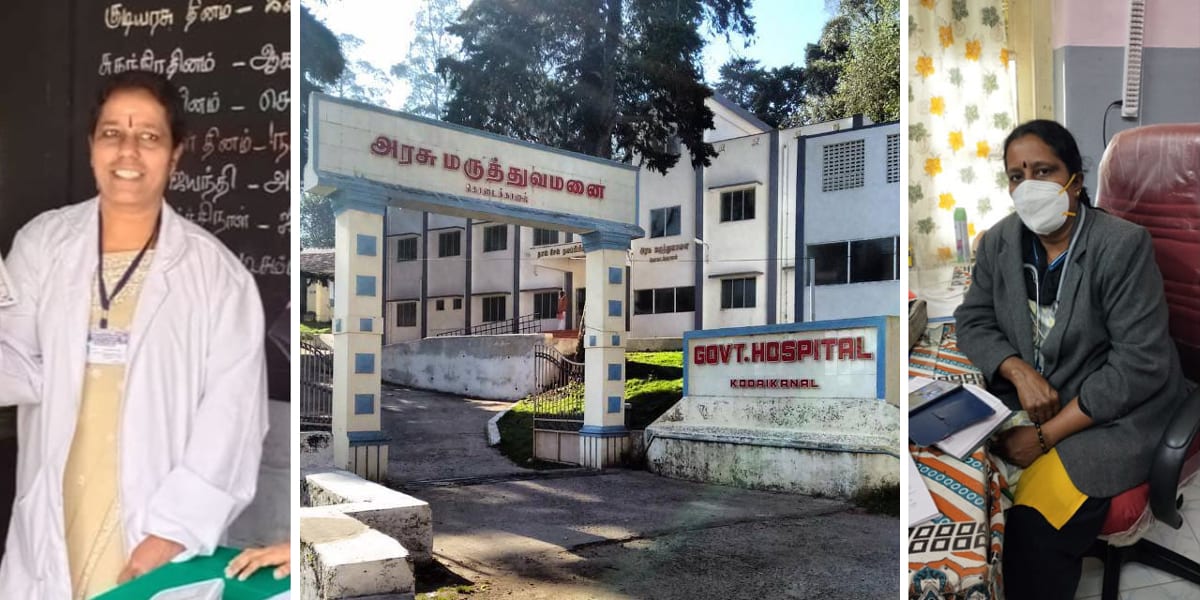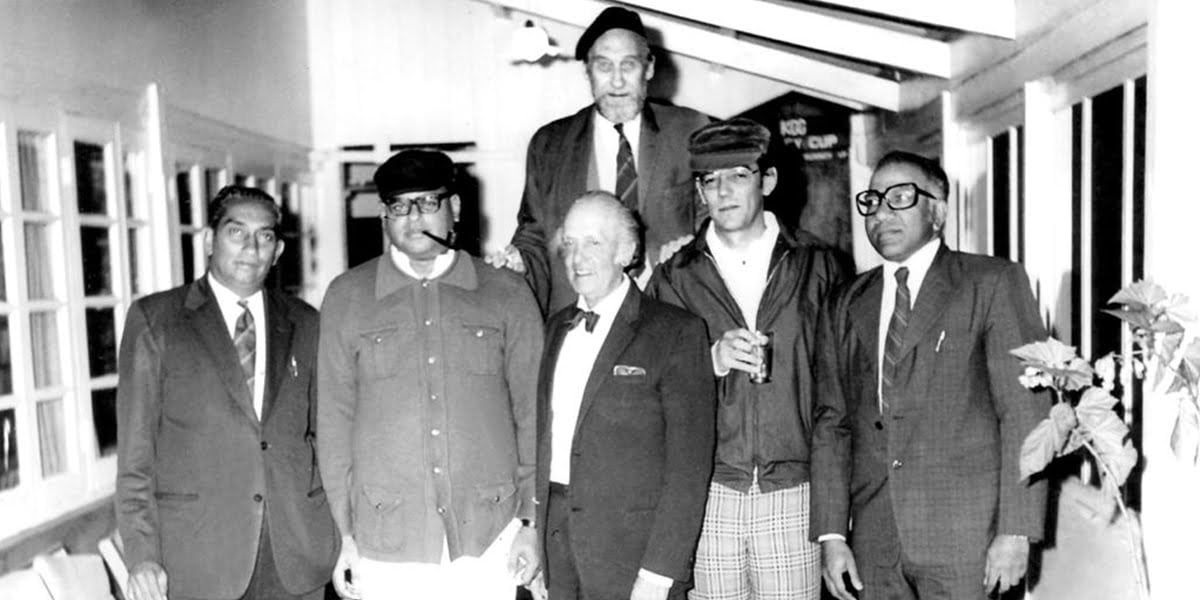Fifty-three-year-old Dr Ponrathi Ponnudurai has been practicing in Kodaikanal for 16 years. Kodai residents remember her in her Maruti van, doing the rounds at medical camps for the government and private organizations, organized around maternity, child health, and non-communicable diseases. After training at Rajah Muthaiah Medical College, Annamalai University and ten years of practice in Theni, Dr Ponrathi joined Kodaikanal’s Government Hospital (GH) last January as Chief Doctor-in-Charge. In just a few months, she was contending with the local fallout of a global pandemic—a reality that hit home during the ongoing second wave.

Last month, Dr Ponrathi spoke to Dr Maheshwari Ravi, a part-time Kodai resident and retired gynaecologist, about her experience in the field. Edited excerpts from a conversation that took place between the two doctors on May 25th, 2021 follow.
Dr Maheswari: It’s nice to be talking to you after a long time.
Dr Ponrathi: Thank you, madam.
Dr M: As a doctor working in the GH in Kodaikanal, how do you feel treating Covid-19 cases in an area like Kodaikanal?
Dr P: Our real outbreak of Covid-19 has been in the second wave, which is still not very high as compared to patients in the plains. However, the positivity rate is high. What I see here is that patients voluntarily choose to not come for testing, except for a few who are educated. Sometimes, they have their own oximeter to check oxygen levels. Invariably, most patients convince themselves they have an ordinary cold and take some aspirin. We cannot go by the definitive positive history. Anyone with mild flu-like symptoms or even dysentery, diarrhoea, conjunctivitis, and unusual body pain, definitely fits into current Covid instructions. So, whether positive or negative, we advise that as a first strategy, to be isolated and then to get tested, but how far people adhere to the advice given is uncertain.
No one wants to believe they have Covid. It is considered a social stigma and this bothers people more than the actual disease.
Dr M: How was the first phase of Covid-19?
Dr P: Last year also we had a large number of patients but in this second wave, we see more patients with SARI symptoms ie Severe/Acute Respiratory Illness. This is the reason there have been more reported deaths now than in the previous wave.
Dr M: As of today, how many positive cases have come to your notice from the health officials?
Dr P: In March, we had one positive case and in April there were 85 positive cases, about 25 cases with SARI symptoms. As of 25 May, in all of Kodaikanal, about 120 Covid-19 patients have been treated.
Dr M: Did they all come based on symptoms or did some of them come just to be sure whether they have Covid-19 due to travel or contact history?
Dr P: The government has given us syndromic management, wherein all patients, irrespective of travel and vaccination history, must be treated as Covid-infected. First off, we request them to be in home isolation. Then we ask them to do a simple breath count to check if they are able to hold their breath for about 20 seconds or more. We check their temperature, which may be high grade or low grade and should be monitored. So, if their temperature is above normal, we tell them to remain under home isolation, and prescribe paracetamol for fever and body ache; also Vitamin C, Zinc, and Azithromycin, all for three to five days. That is the strategy for influenza-like illnesses.
When patients have influenza-like illnesses plus other unusual symptoms, and cannot hold their breath for 18 seconds, we treat them as Covid-infected patients. If their oxygen saturation in the blood is below 95%, they can be managed at the primary health centre or Covid care centre.
Dr M: Is this in and around Kodai, apart from the GH?
Dr P: Yes, there is one in Mother Teresa Women’s University for asymptomatic patients below the age of 40, and another is being opened tomorrow at the municipality guest house where mildly symptomatic patients will be admitted. If the primary health centre has capacity, they too can admit patients. This is the strategy and protocol being followed throughout Tamil Nadu, and the patient’s physical presentation determines where they can be kept.
In category three, ie patients with oxygen saturation less than 90 but within 85 or so, [those with] a breath count less than 15-18 seconds, persistent fever and severe cough, should be hospitalized and administered appropriate medication: Azithromycin, Vitamin C, Zinc. Patients will be required to take, by injection, steroid Dexamethasone or Methylprednisolone, and low molecular weight heparin. Those things will be given in the general strategy.
Last come severe patients, with oxygen saturation below 70%. They definitely need tertiary care, that is in the Dindigul Medical College where they may be put on ventilators. And apart from regular advice and prescribed medication, we have been asked to emphasize breathing in the prone position to improve lung ventilation.
Dr M: Breathing in the prone position is basically advice for the mild to moderate, isn’t it?
Dr P: No no, it’s for all patients, at home as well as patients on ventilation in hospital. Prone ventilation with high flow nasal oxygen, and non-invasive ventilation come under tertiary care. In our setup, these are the things we have to follow.
Dr M: Okay. Now apart from the blood test and swab test, and all other tests you have mentioned so far, is there anything additional you had to do like a CT scan for any of these patients?
Dr P: Actually, yes. They advise an X-ray, but on an X-ray we won’t be able to make out ground glass opacification (GGO). So, CT is the diagnostic tool, and actually, because we have a CT machine, we are able to boldly treat patients. It is a boon [to know] whether we can treat this patient at another level or they need tertiary care.
Dr M: When seeing patients on a CT scan, what are the signs that indicate you cannot treat the patient here and would need to be sent for better care to the plains?
Dr P: If the GGO appearance is more than 30%, we don’t take a chance. From 0 to 10 percent, we treat them in Kodai.
Dr M: Okay. So, from your experience treating Covid patients, is there anything special you want to mention?
Dr P: Yes, madam. In the high-altitude location of Kodaikanal, asymptomatic patients maintain a normal blood saturation in the daytime but at night when it is colder, they show saturation below 92 or 90. The second thing is, in very hot and humid climatic conditions, room windows are kept open for better ventilation but that cannot be done here.
These are contributing factors to the hazard we currently face. However, a positive aspect in Kodaikanal is that patients here recover better than in the plains.
Dr M: What is the reason for that?
Dr P: There is a lot of confusion regarding this. Residents of Kodaikanal are physically active which gives them better lung capacity. Despite this advantage, Covid patients here already have lung involvement and their GGO is higher because of delay in seeking treatment at the hospital.
Dr M: So their ability to cope with the breathing difficulties is better because of the hills they have to walk around on?
Dr P: Yes, provided they are not smokers.
Dr M: So how would you advise a patient… Anything not revealed to the public?
Dr P: Actually, this is a public health hazard. It is the duty of every citizen to go to the hospital and get checked/tested if they have any symptoms, and keep themselves isolated until this is done. If the test is positive, they must report to the doctor for suitable treatment and a proper examination to confirm whether they fit [the] criteria for home isolation or need to be referred to the Covid care centre. Secondly, since we are in a pandemic, even for mild flu-like symptoms, the first diagnosis is Covid, second diagnosis is Covid, third diagnosis is Covid. Only after seeing test results can we be sure [whether there is] Covid infection or not. Another thing is, a negative result does not mean there is no Covid, because the variant strain doesn’t always show positive results.
Dr M: In other words, we have to create awareness or make it a rule for private practitioners to send patients as soon as they have symptoms, to not waste time and to not play the fool with their patients.
Dr P: The saddest part is, people think if they go to GH they will be labelled as Covid patients and admitted there. Therefore, they go to private practitioners and we don’t know what social distance is being maintained at their clinics. An asymptomatic patient and a symptomatic one may be in close proximity and whether they wear triple-layer masks or N-95s, I think they are highly prone because the viral load will be more.
Dr M: Do you think that a notice could be placed in front of private clinics to say ‘with these symptoms kindly do not come inside without following social distancing and mask wearing protocols’ or ‘with these symptoms please go to the nearest diagnostic or public health centre to get tested’?
Dr P: Absolutely, they should refuse to treat such patients, only then will they come to the GH. I have a feeling even doctors in the plains should be doing this.
Last night, three patients came in with severe distress. Two of them had been treated by local doctors who had already been requested through the Indian Medical Association (IMA) to send patients here to get tested, or at least keep them in home isolation and then do the test. Their response is that they do tell their patients but they do not follow this advice. Only if all private doctors close their doors to these patients will they definitely come here.
Dr M: As a doctor, is there any special lesson you’ve learnt from this Covid pandemic?
Dr P: Well, after October 2020, there have been no Covid patients to admit. We used to take swabs and all, but these were invariably reported as negative. We used to refer these patients to Dindigul Medical College, even if they tested positive, because the caseload there was low. But now we are forced to treat even moderate symptomatic patients here since the caseload at Dindigul or even at Theni is very heavy and no beds are available there. Patients are just made to wait in the ambulance or in their cars. Very pathetic situation.

Dr M: I think we have sufficient space for the number of cases presently being dealt with here.
Dr P: Yes madam, actually it is dispersed and not so crowded that others will get infected. There is no way a Covid patient can mingle with general patients in the GH as total segregation is ensured.
Dr M: Is your isolation ward full as of now or do you have some space?
Dr P: Yes, it is full. Right now we have about 24 patients. The total bed strength is 52, allocated beds for Covid patients is 35.
Dr M: In that case, do you still have some spare beds?
Dr P: Yes, but actually a reserve of at least 25-30 percent beds are kept empty so that any sudden cluster of new Covid patients could be accommodated.
Dr M: So, are there more asymptomatic patients coming to the GH to get screened or do they go elsewhere?
Dr P: Yes, more and more are coming here to be screened, even asymptomatic patients, and today we did for about 30 patients. The main symptom is Influenza Like Illness (ILI), or who are admitted with severe/acute respiratory illness. For those patients we do the swab test. And screening is done for ANCs (ante-natal care) nearing their due date in the next week or in the next three days, and for postnatal mothers undergoing sterilization.
Dr M: Do all pre-op and emergency patients need to be screened?
Dr P: Yes. And some individuals come for screening before rejoining duty or before travel. Those who want to go to college will be screened through Covid testing. Primary and secondary contacts of patients testing positive for Covid will also do the screening test.
As the hospital does not have a general surgeon as of now, the General Practitioner—who specializes in obstetrics and gynaecology—undertakes all deliveries and obstetric-related emergencies such Caesarian sections and family planning surgeries, following strict Covid-19 precautions.




